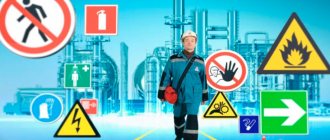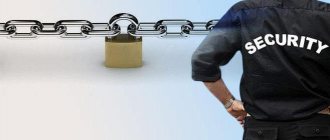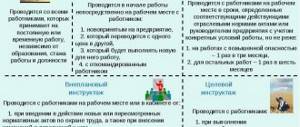In any organization or enterprise, regardless of the form of ownership and activity, there must be a service or division that deals with occupational safety issues. It must interact with all existing functional units and ensure compliance with all rules and regulations, as well as organize a set of measures to ensure the safety of the work process. The personnel employee of the specified department is an engineer or labor protection specialist. Its tasks include conducting certification of workers, developing safety instructions, and carrying out other activities.
What it is
The presented unit has the task of preserving the life and health of the enterprise’s workers. For this purpose, the employer creates the specified service on the basis of regulatory documents. The main personnel of the department are obliged to carry out legal, sanitary, hygienic, medical, preventive and other special organizational and technical measures that are aimed at minimizing the number of injuries and damages, occupational diseases and the number of other emergencies that occur with employees during work.
Service staff
Note! If the company has a small number of employees, then one specialist or an employee appointed by management who has been trained and has the right to do this can perform the duties.
Based on the decisions made, the employer independently establishes definitions and subordination. The establishment and management of the labor protection service, the functions, tasks and rights of employees are established by him in accordance with current legislation.
What rights does the OT service have?
Rights of employees of the OSH service at the enterprise
Along with the assigned responsibilities and control functions, the occupational safety service is granted the following rights:
- Specialists are allowed to visit premises and production areas where work is currently being carried out at any time of the day, and no one can prevent this, neither the head of the department nor the manager of the facility.
- Periodically review the documents on occupational safety, no matter at what level they are adopted, for example, at the federal or local level.
- Based on identified violations, issue oral comments, make entries in journals, and also issue instructions to department heads. Establish control over implementation.
- It is mandatory to require the management of the entrusted facility to undergo medical examinations for employees, conduct training on labor protection, and use personal protective equipment by employees.
- Inform the immediate management of the enterprise about identified violations of a particular person.
- Conduct preventive conversations with employees who have violated safety requirements and demand written explanations from the latter.
- Provide incentives to employees who comply with occupational safety requirements, including maintaining order in the workplace and not blocking free passages.
- Discuss TB issues at meetings.
For each enterprise or organization, these rights will be specified, but the general meaning is that, based on the work done, the safety engineer has the right to write comments, issue instructions, and also recommend employees for reward or punishment. All comments issued must be clearly monitored, only then the activities of the service will be effective.
Main functions
Labor Safety Day in Organizations and Enterprises
The occupational safety department should organize preventive measures, the purpose of which is to minimize risks from hazardous and harmful factors in production activities, reduce and prevent accidents and threats to the lives of employees. The service also monitors compliance with all safety standards. The listed department is engaged in the development of special instructions and regulations, thanks to which certification and training of personnel are carried out.
Specialist tasks
The functional responsibilities that the service must perform are as follows:
- conduct introductory briefings regarding labor safety issues;
- development, preparation and coordination of all decrees that relate to occupational safety issues, as well as submitting them to management for proper execution;
- carrying out various inspections and certifications of compliance with the requirements of regulatory legal acts on occupational safety. Work can be carried out jointly with employees of other departments, as well as representatives from trade unions;
- development and coordination of reporting documents on topics;
- participation in the preparation of sanitary and hygienic parameters of places of work for those workers who are undergoing a medical examination for the presence of occupational diseases;
- take part in internal audits to check workplaces to ensure that they comply with all official documents;
- are developing lists of specialties, positions and professions that must undergo periodic medical examinations;
- conduct accounting and analytical activities on cases of injuries, accidents, emergencies and other incidents at work. Find out the main reasons for what happened;
- are engaged in informing the organization’s employees about state legislation on occupational safety, as well as internal requirements for the enterprise;
- take part in personnel training activities in the specified area and work on the certification commission.
Important! The most responsible task of the unit is to work on a commission that conducts investigations into incidents of injury, damage, and death.
Organization and subordination of the unit
What does the OT service control?
Occupational safety services are mostly assigned control functions, which include control over:
- compliance by employees with local regulatory and legislative documents;
- use of personal protective equipment and RPE;
- implementation of occupational safety measures in accordance with approved plans;
- availability of occupational safety instructions at workplaces, as well as posters and current administrative documents;
- organizing the implementation of SOUT in departments;
- carrying out timely maintenance and other inspections of technical devices on which facility employees work;
- the efficiency of ventilation systems in workplaces requiring installation of the latter;
- storage of devices and personal protective equipment;
- conducting all types of briefings;
- organization of workplaces at the entrusted facility;
- allocation and expenditure of funds for the needs of public safety;
- accrual of compensation payments when working under special working conditions;
- monitoring employees' compliance with sanitary and hygienic requirements;
- serviceability of locking devices.
Employee rights
Policy in the field of labor protection in the organization
The company's occupational safety specialists must monitor compliance with all safety measures and rules that are regulated by law. In cases where a specialist has noticed a violation in work or non-compliance with certain requirements, he can:
- draw up and issue instructions for heads of departments or other structural units. They can indicate detected deficiencies and ways to correct them;
- has the right to request certain documentary acts, data and information relating to their activities in matters of occupational safety;
- have the right to put forward demands for the removal from official duties of those employees who have not undergone a legal medical examination, training, instructions or certification. They may be required to exclude persons without appropriate permission from work;
- develop documentation to punish or hold accountable those workers who violate internal rules and regulations on occupational safety;
- if certain violations are found in the safety of work, they can stop the operation of machines and mechanisms, tools and equipment.
4. Rights
The security service has the right:
4.1. Request from structural divisions materials and documents necessary for the development of measures to support material assets and funds.
4.2. Require enterprise employees to comply with the security regime established on the territory.
4.3. Have access to all enterprise facilities, as well as to all sources and media of enterprise information.
4.4. If there are grounds, check the documents of employees and visitors of the enterprise, workplaces, as well as inspect vehicles.
4.5. Receive explanations, make inquiries and obtain the necessary information.
4.6. Provide explanations, recommendations and instructions on issues within the competence of the service.
4.7. [Enter as appropriate].
back to contents
Whom does it report to?
Occupational Safety and Health Cabinet: who is in charge?
The question of who reports to the labor protection service in an organization arises quite often. The presented unit has a special status and is subordinate to the head of the enterprise.
Note! Regardless of the structural features, whether it is an entire department or just one specialist, they should report only to the immediate director of the entire enterprise.
If the duties are performed by a service of several employees, then the head of this service is installed, who becomes the boss for the rest. However, in domestic conditions, functions are most often performed by only one person.
Who is responsible?
The immediate manager, that is, the general director, is always responsible for the activities of this division. If the service consists of several people for whom a chief is officially appointed, then he is also responsible for the activities of the unit entrusted to him. The employee through whose fault the event occurred is also held directly responsible.
Who manages labor safety in the organization (less than 50 employees)
If the organization has less than 50 employees, responsibility falls on one of them. As a rule, this employee is the immediate manager of the organization. However, if it was decided to assign responsibility to another employee, then this should be formalized by a local regulatory act - an order appointing someone responsible for labor protection. If there is no such act, then the head (general director, manager, etc.) of the organization automatically becomes responsible.
Nuances of structure management
There are certain nuances in the work and management of an occupational safety department:
- the functioning of the service in the organization must take place in accordance with the established schedule and plan, which are approved by the head;
- work places for service personnel should be located in dedicated rooms with a set of organizational equipment and communications;
- specialists cannot be involved in tasks that are not typical for them, which are not provided for by the Labor Code of the Russian Federation, as well as internal documents;
- The department premises should be convenient for visiting.
About service management bodies
Occupational safety and health at the enterprise as a whole is managed not only by HSE engineers, but also by several other organizational structures. These may include various divisions.
The labor protection department performs control functions, as well as functions for the development and implementation of local regulatory documents. All issues related to labor protection are concentrated in this department.
Division of the chief power engineer. This unit plays the role of life support for the facility, that is, its main tasks are: supply of electricity, gas, heat supply, water supply, ensuring the operation of ventilation units, the proper operation of equipment under excess pressure, and much more. This unit concentrates all the key points related to creating comfort and safety in the workplace.
Human Resources Department. The function of the HR department in the occupational safety and health system is to maintain personal records of employees upon entry to work, as well as draw up employment agreements, orders for the admission of employees to work and work outside of working hours, and the calculation of allowances for special conditions of the labor process.
What the law says
The Labor Code clearly states that a labor protection specialist or an entire department is appointed directly by the director. The specialist must meet the established requirements, that is, have the proper qualifications and education. If the established functions are performed by the manager independently, then he is also required to undergo training and certification.
Managment structure
Commentary on Article 217 of the Labor Code of the Russian Federation
Article 217 of the Labor Code of the Russian Federation determines the issues of creating a labor protection service in an organization. Part one of this article obliges employers who conduct production activities to create such a service or introduce a full-time position of a labor protection specialist.
Please note: the title of Article 217 of the Labor Code of the Russian Federation says that such service is only in organizations, but the text of the article itself refers to employers. It turns out that its norms also apply to individual entrepreneurs.
Every employer carrying out production activities and whose number of employees exceeds 50 people is required to create a labor protection service (introduce the position of a labor protection specialist).
The order to create a service looks like this:
In accordance with Article 217 of the Labor Code of the Russian Federation:
1) Create a labor protection service in the organization (enterprise).
2) To the Head of the Human Resources Department:
prepare a staffing table for the labor protection service as a structural unit of the organization;
prepare “Regulations on the labor protection service.”
3) Carry out these activities before “___” ___________ _____.
An order for the introduction of a full-time position can be drawn up as follows:
1) Introduce the position of occupational safety specialist at the enterprise (organization).
introduce the position of occupational safety specialist into the staffing table;
prepare “Job responsibilities of a labor protection specialist.”
Director Vasilyeva I.A.
If the employer employs less than 50 people, then the decision to create an occupational safety service or introduce the position of an occupational safety specialist is made taking into account the specifics of its production activities. If such a decision is not made, then the labor protection functions are carried out by the head of the organization, another employee authorized by the employer, or the employer is an individual entrepreneur.
Expert opinion
Mikhailov Vladislav Ivanovich
Lawyer with 6 years of experience. Specializes in family law. Knows everything about the law.
It is also allowed to conclude a civil contract with an organization or specialist providing services in the field of labor protection (Part 3 of Art.
217 of the Labor Code of the Russian Federation).
Organizations providing services in the field of labor protection are subject to mandatory accreditation. The list of services, the provision of which is subject to accreditation, and its rules are established by the relevant federal executive body.
The last part of the commented article establishes that the structure of the labor protection service in the organization and the number of labor protection service employees are determined by the employer, taking into account the recommendations of the federal executive body that carries out the functions of legal regulation in the field of labor, that is, the Ministry of Health and Social Development of Russia. True, at present the Recommendations for organizing the work of the labor protection service in an organization are still in force, which were approved by the Resolution of the Ministry of Labor of Russia dated February 8, 2000.
N 14.
Creation, organization of service and calculation of personnel
The structure of the service lies in the department of the general director. Parameters for organization and structure are established depending on the total number of staff, the specifics of the work, the danger of production and many other indicators. All parameters are regulated by Inter-industry standards for the number of workers in the occupational safety service, which are located in the department of the Ministry of Labor.
The legislation states that if the number of personnel is more than 50 people, duties can be performed by one person or service. With fewer employees, responsibilities can be entrusted to one specialist or responsible person with suitable qualifications. When the enterprise system has a staff of less than 20 people, the manager has the right to relieve specialists from their duties and involve third parties who are trained.
If there is no occupational safety specialist in the company, and the number of official personnel is no more than 50 people, then the manager has the right to perform his duties personally. He also has the right to appoint a specialist from among the employees to perform the duties using an order.
Note! You can enter into a contract with a third-party organization that has all the necessary certificates and permits to engage in such activities.
The labor protection service in a company or organization reports to the manager. All duties and functions of the unit are established by law and internal documentation. Full responsibility for the activities of the service lies with the director of the enterprise and the head of the service itself, if one exists.
Structure of the labor protection service
Management of the labor protection service is entrusted to the heads of the organization, taking into account:
- number of employees;
- working conditions;
- existing harmful and dangerous conditions at work;
- other factors.
The regulatory framework that determines the structure, number and other issues related to the organization of the service in question is the Intersectoral Standards developed by Resolution of the Ministry of Labor of the Russian Federation dated January 22, 2001 No. 10. In addition to this document, there is another one - Recommendations on the organization of labor protection services (Resolution of the Ministry of Labor of the Russian Federation dated 02/08/2000 No. 14).
The recommendations provide for a provision according to which the structure of the service includes the head of the unit and specialists who are directly subordinate to the head.
The number of specialists is determined on the basis of the provisions provided for by Intersectoral Standards. The standard number of personnel from which the security service is formed is established on the basis of a calculation that takes into account the functions that the labor “security guards” will perform, as well as other parameters, including:
- number (average) of employees in the organization;
- the number of workers working in hazardous production or associated with harmful and dangerous factors.








